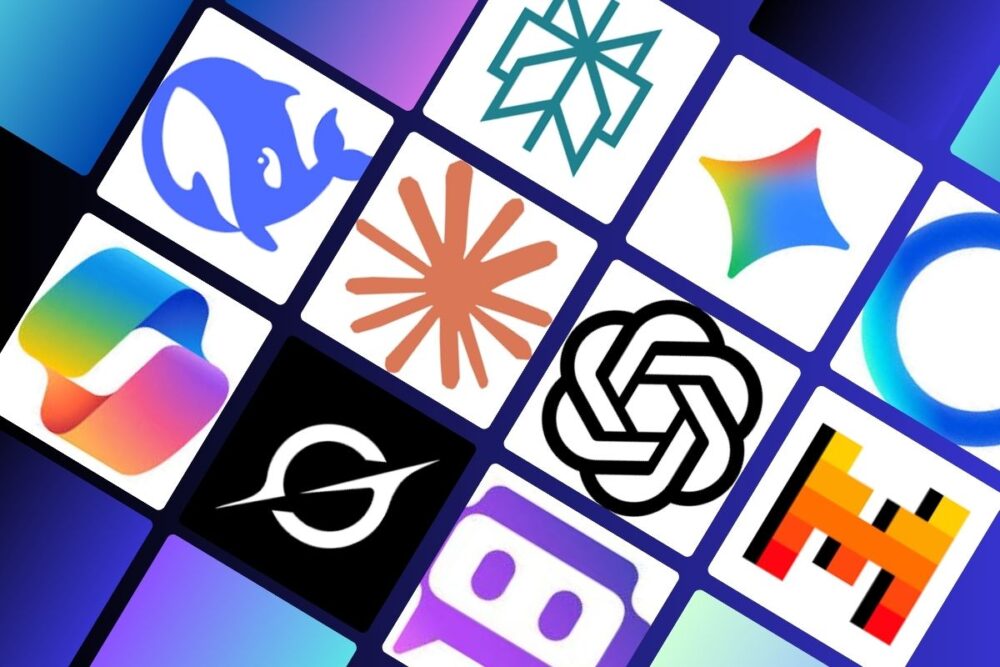With AI chatbots rapidly becoming a crucial interface between humans and machines, the question isn’t “Do they work?” but rather “Which ones dominate—and why?” Drawing on web traffic, growth trends, media attention, and user engagement, the AI “Big Bang” Study 2025 by SEO agency onelittleweb.com offers a data-backed snapshot of the top-performing AI chatbots today. If you want to know who’s leading the AI chatbot revolution, read on. We’ll also explain what this means for businesses and industry professionals like you, readers of DirectIndustry, and how to choose the right tool with the best strategy.
Our world is now full of AI chatbots, and it’s no coincidence that people are asking: What is the best chatbot to use? If you ask someone which chatbot they use regularly, the vast majority will probably answer ChatGPT. And if you ask them to name a few others, ChatGPT will almost always be in the top three, often followed by Gemini and Perplexity (and Mistral, if you happen to be in France).
But the real question is: what are the best ones? Because although they are all based on generative AI, they don’t offer the same features and capabilities. Depending on your business activity, one might be more suitable than another.
Read also
The AI Chatbot Landscape
SEO agency onelittleweb.com studied over 10,500 AI tools on the market from August 2024 to July 2025. They ranked the top 10 AI chatbots of 2025 using measurable data from sources like Semrush, Muckrack, aitools.xyz, and app stores.
According to their AI Big Bang Study 2025 (available here), AI tools overall amassed nearly 100 billion web visits between August 2024 and July 2025. Yet, the top 10 chatbots alone accounted for 58.88 billion visits (58.8% of this traffic). This indicates a steep consolidation of user attention around a few dominant platforms.
What Are the Top AI Chatbots?
At the heart of it all, as we wrote before, is ChatGPT. OpenAI’s flagship product captured nearly 46.6 billion visits, representing a staggering 48.36% of all traffic in the AI space. The other nine chatbots combined make up just 10.45% of this traffic.
And ChatGPT’s growth keeps accelerating. Average monthly visits hit 5 billion per month in the latest quarter (May–July 2025), up from 3.88 billion per month over the full year.
So, despite the rapid emergence of new contenders, these figures highlight ChatGPT’s sustained dominance in user preference and engagement.
The ranking below highlights which platforms attract the most users, and therefore set the pace for the industry.
The AI Big Bang Study Ranking
| Rank | Tool Name | Final Score | Annual Web Visits | Media Citations | Visits YoY Growth (%) | Visits MoM Growth (%) | Traffic Market Share (%) | Avg. Session Duration (Min.) | App Store Reviews | App Store Ratings |
| 1 | ChatGPT | 0.81 | 46.59B | 2.4M | 106% | 12.27% | 48.36% | 15:25 | 26.2M | 9.70 |
| 2 | Grok | 0.42 | 686.91M | 319.5K | 1,343,408% | 37.32% | 1.17% | 15:43 | 1.4M | 9.70 |
| 3 | Gemini | 0.32 | 1.66B | 1.8M | 156% | 7.65% | 1.74% | 11:13 | 9.4M | 9.30 |
| 4 | Claude | 0.27 | 1.15B | 1.0M | 201% | 17.73% | 1.07% | 16:44 | 118.9K | 9.40 |
| 5 | DeepSeek | 0.24 | 2.74B | 1.4M | 48848% | -4.76% | 3.96% | 12:54 | 186.1K | 8.00 |
| 6 | Perplexity | 0.23 | 1.47B | 215.0K | 227% | 21.99% | 1.42% | 13:14 | 1.1M | 9.60 |
| 7 | Microsoft Copilot | 0.20 | 957.19M | 113.1K | 348% | 15.81% | 0.86% | 09:04 | 1.7M | 9.60 |
| 8 | Poe | 0.18 | 378.05M | 39.6K | -46% | -3.37% | 0.00% | 13:56 | 479.1K | 9.30 |
| 9 | Mistral | 0.18 | 101.39M | 199.6K | 420% | -0.80% | 0.07% | 11:34 | 10.2K | 9.50 |
| 10 | Meta AI | 0.17 | 130.35M | 197.6K | 468% | 0.80% | 0.16% | 12:36 | 38.3K | 8.20 |
| Total | 55.88B | 7.7M | 123.35% | 11.85% | 58.81% | Avg. 13:14 | 40.6M | Avg. 9.2 | ||
Courtesy of onelittleweb.com
Fast Movers, Deep Engagers & Slower Risers
Even with ChatGPT’s undisputed lead, the AI chatbot universe isn’t static. Several emerging players are carving out impressive momentum.
Here’s what you should note:
- Grok is the fastest riser among the top 10 AI platforms and is ranked 2nd by onelittleweb. It is gaining ground through dramatic month-on-month and year-on-year traffic growth, strong media appearances, long usage sessions, and positive app reviews. It grew from just 51K visits to 687M—a staggering +1,343,408% increase year-over-year. For the authors of the study, this type of leap, which is rare even in emerging tech, could be fueled by platform-native distribution like X.
- While Gemini holds 2nd place for annual visits (1.66B), it is ranked 3rd overall by onelittleweb. The platform logged over 1.7 billion visits and grew by 156% YoY. Its average monthly visits soared to 246.2 million in Q3 2025, though it still trails ChatGPT by a wide margin.
- Claude topped the leaderboard in user engagement, clocking the longest average visit duration at 16 minutes and 44 seconds. This indicates deeper, more sustained user interaction.
- Perplexity and Claude both sustained steady, reliable growth. This suggests they’re building loyal user bases over time rather than chasing explosive short-term spikes.
- The study also reveals that DeepSeek experienced a meteoric rise (peaking at 520 million visits in February 2025) before falling sharply. The Chinese chatbot lost 39.5% of web traffic by July.
Expert Insights
We contacted Sujan Sark, co-founder of onelittleweb.com. According to him:
“Claude’s average session time of 16:44 minutes per visit is nearly double that of many competitors, suggesting that users are not just querying, but sustaining long, complex interactions. This points to high engagement depth—the kind of usage where context, memory, and iterative reasoning matter.”
He also adds that DeepSeek exemplifies the volatility of the AI chatbot market:
“After explosive growth to 2.7B visits (+48,848% YoY) and a peak of 520M monthly visits in February 2025, it lost momentum fast, dropping 39.5% by July. Mentions fell from 1.1M to just 61.6K in five months—a collapse driven by fading buzz.”
Why Does This Matter to DirectIndustry Readers?
For professionals evaluating AI chatbots for enterprise, industrial, or technical applications, these insights carry strong implications. Here is what you should know:
1. Build Multi-Chatbot Strategies
With half the traffic going to ChatGPT, enterprises must decide whether to bet on the leader or diversify across rising alternatives. But one thing is certain: ChatGPT isn’t just a tool. It has become an inevitable touchpoint for customers and employees alike.
According to Sark:
“The concentration of traffic among a few chatbots signals both opportunity and risk for enterprises. On the one hand, ChatGPT’s 46.6B visits (+106% YoY) show its maturity, stability, and global adoption. For businesses integrating AI into workflows, this offers confidence that the infrastructure and ecosystem around ChatGPT will remain strong.”
But fast-growing names like Grok (686.9M visits, +1,343,408% YoY) and Gemini (1.7B visits, +156% YoY) may offer distinct capabilities. Grok, for instance, may provide unique features or integrations that appeal to niche industries—potentially giving organizations an edge if adopted early.
“Relying on a single provider may limit flexibility, pricing leverage, and exposure to new features. Diversification—testing and integrating more than one chatbot—allows companies to hedge against disruption, ensuring continuity if one tool falters or becomes less competitive.”
If ChatGPT is the safe bet, smart enterprises are already building multi-chatbot strategies to stay agile.
2. Use Specialist Chatbots
Longer session durations (for example Claude’s ~17-minute visits) show that some AI platforms don’t just attract attention—they retain it and deliver richer user experiences. This makes them more suited to environments where quality of interaction outweighs sheer scale.
This is crucial for certain businesses, explains Sark:
“Industries that depend on diagnostics, research, or problem-solving stand to benefit the most from tools like Claude. In healthcare, for example, it can support long symptom discussions for diagnosis, differential analysis, or patient intake simulations. In R&D, it can be used for brainstorming, literature review, or multi-step hypothesis testing. In manufacturing and support, it can assist with troubleshooting workflows, compliance checks, or knowledge retrieval.”
3. Watch the Volatility
As DeepSeek shows, rapid growth doesn’t always guarantee long-term staying power. Businesses should ask themselves: How wise is it to rely on a technology that might not be around in 2–3 years?
Sark warns:
“The lesson for enterprises: hype cycles don’t equal long-term stability. Betting heavily on a single fast-riser exposes businesses to risk if that tool fails to sustain product updates, funding, or market relevance.”
According to him, enterprises should evaluate multi-year roadmaps of providers, not just short-term adoption spikes. They should also balance market share leaders (ChatGPT, Gemini) with specialists (Claude, Perplexity) to ensure resilience, and build modular AI workflows that allow them to swap tools if one declines.
“In other words: pick for stability + flexibility, not just novelty.”
For industrial players, the message is clear: choosing an AI chatbot is no longer just about functionality. It’s about long-term reliability, engagement, and strategic alignment with your industry’s needs.
Read our other stories on Generative AI








![Image [Buying Guide] How to Choose the Right AMR?](/wp-content/uploads/sites/3/AMR-320x213.jpg)


